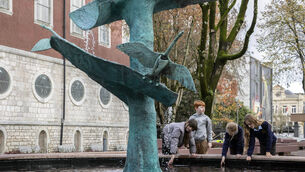A modern take on the century old tragedy of Michael Collins

The sadness at Collins’ death continues a century later because his story embodies the tragedy of the Civil War, good men on both sides killed by former comrades and friends, just as the much longed for independent Ireland began to bloom.
However, in the immediate aftermath, on August 23, 1922, the practicalities of paying respects, praying for his soul, and transferring his body to Dublin for burial in Glasnevin Cemetery took over.
After a lengthy and horrendous journey back to the city from Béal na Bláth due to blocked roads and destroyed bridges, Collins was laid out in Shanakiel Hospital.
News of the death of the Commander-in-Chief got out quickly and ordinary citizens started to arrive at the hospital to say goodbye to the most famous man in Ireland.
Soldiers lined the route to the hospital and when the prayers of the dead were completed, Collins’ coffin was shouldered by members of his convoy, including his right hand man Major General Emmet Dalton, to the hearse which proceeded down Western Road, Washington Street, Patrick Street and on to Penrose Quay.
Only hours previous, Dalton had telegraphed Army HQ with the desperate message: “To General Staff, Dublin,Commander-in-Chief shot dead in ambush at Bealnamblath near Bandon 6.30 Tuesday evening with me. Also one man wounded. Remains leaving by Classic for Dublin today Wednesday noon. Arrange to meet. Reply. Dalton.”
The Cork Examiner described the scenes on the quays: “When it became known in the city that the body was being taken to Dublin by the SS Classic, people in large numbers thronged the quays, and by the time the funeral cortege approached, Patrick’s quay and Merchant’s quay were crowded”
The armoured car Slievenamon which had accompanied Collins on his tour of West Cork the day before was loaded on and members of his family and local dignitaries travelled on board.
The Cork Examiner described the sad scene as the ship departed. “At 1.40 the vessel broke from the quayside and steamed slowly down the river. As it did so all heads were again uncovered, and the citizens of Cork watched it out of sight as it bore away the remains of a young Corkman, who was a statesman as well as a soldier, and whose qualities in peace as well as in war made him one of the most popular figures in Irish public life, and a man of whom Cork was justly proud.”
As the ship neared Cobh, the high bell on St Colman’s Cathedral sounded over the harbour and later Dalton recounted how a British destroyer fleet nearby sounded the Last Post “and the strains of the music over the water was most impressive - so very touching. It would bring tears to a stone”.
I have been interested in Collins since I studied History for the Leaving Cert and researched him as my specialist project, most likely inspired by Neil Jordan’s film released the previous year.
My interest was a product of the renewed attention in Collins in the 1990s, partly driven by the publication of Tim Pat Coogan’s biography in 1990 and by his grandnephew Liam Collins, who orchestrated Collins’ birthplace Woodfield becoming an OPW site and who also helped Neeson in his portrayal of the Big Fellow.
The last definitive TV telling of Collins’ story was in 1989, by RTÉ’s Colm Connolly in The Shadow Of Béal na Bláth, so when the opportunity to work on the centrepiece of RTÉ’s output on the centenary of Collins’ death came up, I gladly accepted.
Cold Case Collins is a “twisty history” programme, one that uses contemporary storytelling techniques to tell a historical story. Previous productions like Election 18 and Treaty Live used the conventions of a live current affairs show on election night to delve into the results of the 1918 election when Sinn Féin swept the boards, and the Dáil vote on the Anglo Irish Treaty in January 1922.
Cold Case Collins embraces the protocol of a police procedural drama to imagine what a Garda investigation into Collins’ death in 1924 might have looked like - pulling in key witnesses for questioning, trying to get to the bottom of how the Commander-in-Chief could be killed in a skirmish on an anonymous road in West Cork.
In parallel runs a factual examination of the accounts and artefacts that have survived a century.
Former state pathologist Professor Marie Cassidy chairs a panel of experts including a military historian, conflict archaeologist and experts from Forensic Science Ireland and the Garda National Technical Bureau, to pore over the facts and bring 21st century analysis to bear on a 100-year-old case.
This assembly of experts has discovered new information in relation to Collins’ death which lays some conspiracies to rest and makes Cold Case Collins essential viewing.
Watch Cold Case Collins on RTÉ1 Wednesday, August 24 at 9.35pm







 App?
App?







